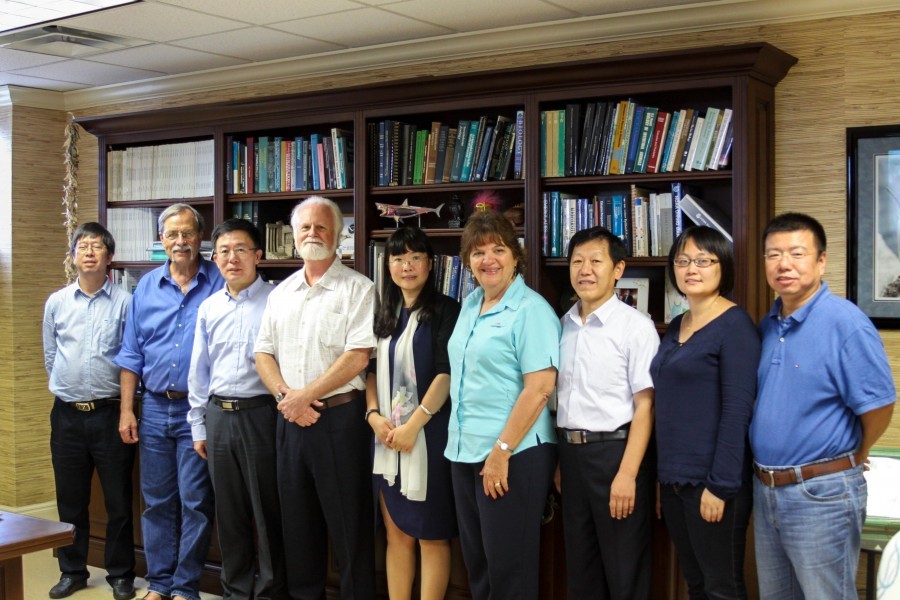Q&A: Chinese fisheries scientists visit Mote, highlight need to meet growing seafood demand
Photo: On Friday, Sept. 18, Mote Marine Laboratory research leaders greet scientists from the Yellow Sea Fisheries Research Institute and Yantai University in China, who visited Mote to share knowledge about fisheries research designed to help feed growing populations. (Credit Mote Marine Laboratory).
With dwindling supplies of seafood for Earth’s growing population, fisheries enhancement and aquaculture (fish farming) research are needed more than ever, said Chinese scientists from the Yellow Sea Fisheries Research Institute (YSFRI) who visited Mote Marine Laboratory on Thursday and Friday to exchange knowledge under a long-term agreement designed to benefit fisheries.
More than half the world’s seafood is supplied by aquaculture, with many wild fish stocks overfished and declining. Scientists at both Mote and YSFRI are seeking solutions by developing aquaculture technology to raise seafood sustainably, while studying the best ways to enhance wild fisheries by strategically releasing hatchery-reared fish.
Mote scientists have been interacting with YSFRI since 1990, and in 2012 the two institutions’ shared missions led to a Memorandum of Understanding designed to support knowledge sharing, research collaborations, graduate student exchanges and more.
On Friday, Sept. 18, YSFRI’s Director General, Dr. Xianshi Jin, discussed why people should care about fisheries research and shared his reactions to Mote’s fish-focused research programs.
Q&A with Dr. Xianshi Jin:
How important is the issue of declining fisheries?
The supply of fish from fisheries is not enough to feed people. To meet the human demand for seafood, I think aquaculture is the future. In China, we face even more issues with overfishing than you do here in the U.S. In China, saltwater aquaculture has produced more seafood than marine capture fisheries since the year 2006. Aquaculture production is much higher there than in the U.S. Integrated multi-trophic aquaculture (IMTA) has been used in China for many years. (IMTA involves raising aquatic species like fish, plants and shellfish together. These systems may raise plants on nutrients from fish waste and/or have shellfish feeding on drifting particles, thus helping filter water.)
What aquaculture topics are you exploring in this U.S. trip?
We asked Mote’s Dr. Ken Leber to arrange visits for us to hatchery stations in the U.S. (culminating at Mote Aquaculture Park in eastern Sarasota County), to discuss marine fisheries stock enhancement, because we have similar programs in China. We’re taking this chance to share knowledge, share experience, learn about things we might not have done. There is such great public interest here in the ocean, in conservation. As people learn about the ocean, they can learn about how to conserve it. The sustainable utilization of ocean resources is a main purpose for both Mote and for us.
What interests you at Mote?
People need seafood and most of it is going to come from aquaculture. We need to do this with reduced, or no, pollution around coastal areas. Recirculating aquaculture — with zero discharge of wastewater like in your research systems at Mote — are an important effort and can produce minimal pollution while raising good seafood. We are also interested in the genetics of fish in aquaculture. My postdoctoral scientist from YSFRI (studying genetics of aquaculture pompano) stayed here at Mote for six months. This strengthened the tie between our institutions.
How do China and the U.S. compare in enhancing wild fisheries?
Around the U.S. coast, fisheries stock enhancement programs in each state might use a few species, but in China we have quite a lot. In saltwater, something like 40 species along the coast are the focus of marine stock enhancement.
At Mote Aquaculture Park, we raise Florida saltwater fish like red drum and snook, along with salt tolerant plants for food and environmental restoration. What do Chinese aquaculture programs work with?
We are raising seaweed, shrimp, shellfish, finfish, and even jellyfish and sea cucumbers.
Jellyfish and sea cucumbers?
Yes, jellyfish and sea cucumbers are food – particularly in eastern countries. Chinese, Japanese, Korean… many people like them. Sea cucumber is worth around $4-5 billion U.S. dollars per year in China. It’s good for people’s health, so in China we call it sea ginseng. But it really has no taste. The dressing flavors it.
For Mote scientists, international collaborations allow all participants to gain new perspectives and combine their strengths on crucial research topics. Mote’s guiding roadmap, the 2020 Vision & Strategic Plan, emphasizes increasing international partnerships and institutional agreements that benefit today’s research for tomorrow’s oceans.
“Mote’s focus on conservation and sustainable use of marine resources has brought us together with many other top research institutions around the world,” said Dr. Michael P. Crosby, President & CEO of Mote. “Our Chinese colleagues at the Yellow Sea Fisheries Research Institute recognize, as we do, that Earth’s future depends upon healthy oceans. We are learning from each other while setting an example of marine science-based diplomacy, which is necessary for sustaining populations of marine species that know no international borders.”
